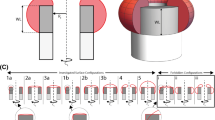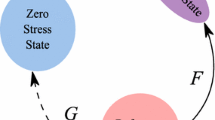Abstract
This study formulates a theory for multigenerational interstitial growth of biological tissues whereby each generation has a distinct reference configuration determined at the time of its deposition. In this model, the solid matrix of a growing tissue consists of a multiplicity of intermingled porous permeable bodies, each of which represents a generation, all of which are constrained to move together in the current configuration. Each generation’s reference configuration has a one-to-one mapping with the master reference configuration, which is typically that of the first generation. This mapping is postulated based on a constitutive assumption with regard to that generations’ state of stress at the time of its deposition. For example, the newly deposited generation may be assumed to be in a stress-free state, even though the underlying tissue is in a loaded configuration. The mass content of each generation may vary over time as a result of growth or degradation, thereby altering the material properties of the tissue. A finite element implementation of this framework is used to provide several illustrative examples, including interstitial growth by cell division followed by matrix turnover.
Similar content being viewed by others
Explore related subjects
Discover the latest articles and news from researchers in related subjects, suggested using machine learning.References
Ateshian GA (2007) On the theory of reactive mixtures for modeling biological growth. Biomech Model Mechanobiol 6(6): 423–445
Ateshian GA, Costa KD, Azeloglu EU, Morrison BI, Hung CT (2009) Continuum modeling of biological tissue growth by cell division, and alteration of intracellular osmolytes and extracellular fixed charge density. J Biomech Eng 131(10): 101
Biot M (1962) Mechanics of deformation and acoustic propagation in porous media. J Appl Phys 33(4): 1482–1498
Biot MA (1972) Theory of finite deformations of porous solids. Indiana U Math J 21(7): 597–620
Bowen RM (1968) Thermochemistry of reacting materials. J Chem Phys 49(4): 1625–1637
Bowen RM (1969) The thermochemistry of a reacting mixture of elastic materials with diffusion. Arch Ration Mech An 34(2): 97–127
Bowen RM (1976) Theory of mixtures. In: Eringen AE (eds) Continuum physics, vol 3. Academic Press, New York, pp 1–127
Bowen RM (1980) Incompressible porous media models by use of the theory of mixtures. Int J Eng Sci 18(9): 1129–1148
Cowin SC, Hegedus DH (1976) Bone remodeling-1. Theory of adaptive elasticity. J Elasticity 6(3): 313–326
Greenwald SE, Moore JEJ, Rachev A, Kane TP, Meister JJ (1997) Experimental investigation of the distribution of residual strains in the artery wall. J Biomech Eng 119(4): 438–444
Guillou A, Ogden RW (2006) Growth in soft biological tissue and residual stress development. In: Holzapfel GA, Ogden RW (eds) Mechanics of biological tissue. Springer, Berlin, pp 47–62
Holmes MH, Mow VC (1990) The nonlinear characteristics of soft gels and hydrated connective tissues in ultrafiltration. J Biomech 23(11): 1145–1156
Humphrey JD, Rajagopal KR (2002) A constrained mixture model for growth and remodeling of soft tissues. Math Mod Meth Appl S 12(3): 407–430
Huyghe JM, Janssen JD (1997) Quadriphasic mechanics of swelling incompressible porous media. Int J Eng Sci 35(8): 793–802
Klisch S, Van Dyke T, Hoger A (2001) A theory of volumetric growth for compressible elastic biological materials. Math Mech Solids (USA) 6(6): 551–575
Rodriguez EK, Hoger A, McCulloch AD (1994) Stress-dependent finite growth in soft elastic tissues. J Biomech 27(4): 455–467
Skalak R, Dasgupta G, Moss M, Otten E, Dullumeijer P, Vilmann H (1982) Analytical description of growth. J Theor Biol 94(3): 555–577
Taber LA, Humphrey JD (2001) Stress-modulated growth, residual stress, and vascular heterogeneity. J Biomech Eng 123(6): 528–535
Truesdell C, Toupin R (1960) The classical field theories. In: Flugge S (eds) Handbuch der Physik, vol III/1. Springer, Berlin
Volokh KY, Lev Y (2005) Growth, anisotropy, and residual stresses in arteries. Mech Chem Biosyst 2(1): 27–40
Vossoughi J, Hedjazi Z, Borris FS (1993) Intimal residual stress and strain in large arteries. In: Adv Bioeng, ASME, pp 434–437
Wan W, Hansen L, Gleason RL Jr (2009) A 3-d constrained mixture model for mechanically mediated vascular growth and remodeling. Biomech Model Mechanobiol. doi:10.1007/s10237-009-0184-z
Author information
Authors and Affiliations
Corresponding author
Rights and permissions
About this article
Cite this article
Ateshian, G.A., Ricken, T. Multigenerational interstitial growth of biological tissues. Biomech Model Mechanobiol 9, 689–702 (2010). https://doi.org/10.1007/s10237-010-0205-y
Received:
Accepted:
Published:
Issue Date:
DOI: https://doi.org/10.1007/s10237-010-0205-y
Keywords
Profiles
- Tim Ricken View author profile




